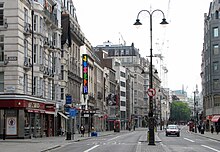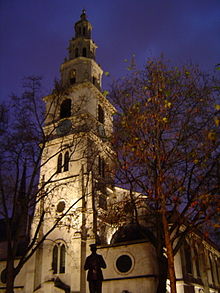Strand (London)
Strand is a street in London . It was the historical link between the City of London and the City of Westminster , which were still separate settlements in the Middle Ages . Until the 17th century , however, the Thames was the main thoroughfare. Today the street begins in Trafalgar Square and runs east to the border of the City of London, where it turns into Fleet Street . The Temple Bar features at this point the boundary of the City of London.
The street is popularly known as The Strand , although the street name is correctly called Strand . The name Strand comes from the Old English language and means, similar to German, bank or river bank . Before the Thames Embankment was built, the road ran right next to the Thames.
From 1793 to 1828, a four-story building called Exeter Change was an indoor zoo on this street. Here in 1826 the Indian elephant Chunee was shot in his cage on the first floor because he could no longer be tamed.
In 1897 there was a murder in front of the Adelphi Theater , to which Bertolt Brecht alluded to in The Moritat by Mackie Messer with reference to the beach .
In the 18th century, the beach was also known for bookshops and publishers. The well-known bookseller and publisher Andrew Millar resided here . The Strand Magazin that was published here was named after the street .
The closest London Underground station is Charing Cross , which is served by the Bakerloo Line and the Northern Line . From 1915 to 1979 this station was named Strand , but was closed from 1973 to 1979. Aldwych Station on the Piccadilly Line , which was called Strand Station before 1915 , was closed in 1994.
building
- Adelphi Theater
- Australia House , the Australian Embassy
- Charing Cross train station
- Bush House
- King's College
- Royal Courts of Justice
- Savoy Palace , demolished in 1381
- Shell Mex House
- Simpson's-in-the-Strand
- Somerset House
- St Clement Danes
- St Mary le Strand
- Zimbabwe House , the Zimbabwean Embassy
The Savoy Hotel and the Savoy Theater are on a side street off the beach.
Coordinates: 51 ° 30 ′ 41 ″ N , 0 ° 7 ′ 8 ″ W.

